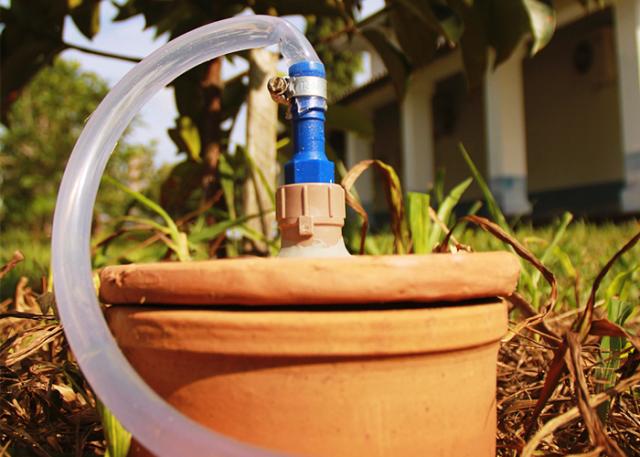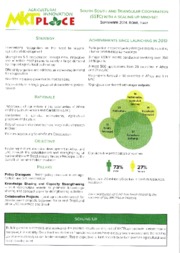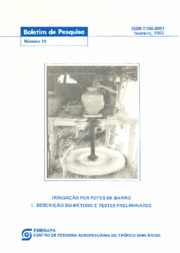Clay pots are low cost irrigation alternative in Brazil and in Africa
Clay pots are low cost irrigation alternative in Brazil and in Africa
The use of clay pots that are much similar to those used to store drinking water in the kitchens of farms and villages in the countryside is being validated as a social technology for low cost irrigation and the rational use of water resources in Brazil and Africa. Through a partnership between Embrapa Eastern Amazon (Pará, Brazil) and Mekelle University, in Ethiopia, the technology was studied and later implemented in Northern Ethiopia, as it was incorporated as public policy for family farming in that country. In Brazil, the project was named "IrrigaPote", includes studies conducted in several regions of Pará state, and already presents positive results in the cultivation of fruit and vegetables.
The technology provides a soil-plant-atmosphere interaction that ensures water supply during extended dry spells, with a focus on family farming, clarifies the Embrapa researcher Lucieta Guerreiro Martorano, who is responsible for the project in Brazil. She explains that, in the process, rainwater is caught by gutters distributed throughout roofs, then stored in reservoirs, and later distributed to clay pots buried alongside the food crops chosen by growers. "A simple technology, that is easy to set up, reuses rainwater and ensures harvests to families, generating income and food security", defends the scientist.
According to the researcher, Embrapa was invited by the African university to join the challenge of finding low cost irrigation solutions that could be easily adopted by farmers, which generated another Brazil/Africa partnership project within the international initiative Agricultural Innovation MarketPlace. The Marketplace aggregates several Brazilian, African, Latin American and Caribbean specialists and institutions to jointly develop research and innovation projects for agriculture, based on the understanding of its fundamental role for growth and to overcome inequalities in the countries.
The project started in 2014 involving researchers from both countries, initially, with the purpose of finding the most suitable technology to face the challenge of family farming in the North of Ethiopia, with the aim of ensuring food security in periods of low rainwater supply. According to project data, in that region, more than 50% of the water available for agriculture is lost due to issues like direct evaporation, surface runoff and deep drainage.
A research challenge to change realities
Once the challenge was launched, the scientist reports that the research hypothesis was to prove the viability of the use of low cost technologies and intelligent solutions to identify strategies for water restoration and water storage in containers, considering, not only price, but also easiness of access to the materials used in the implementation, and easy adoption by the public. The ceramic vases, pitchers, or clay pots were the solution found, but to implement it, it was necessary to discover which pot type or format would be more suited to each crop and measure their efficiency in the field.
For that purpose, the project employed the principles of the agrometeorology, Lucieta 's field of study, which applies meteorology in agricultural activities. "Studying the performance of any irrigation system requires measuring evapotranspiration rates (ET), monitoring phenological stages, and estimating growth and crop yields", she exemplified. This was done to standardize and test the technologies, and to assess their technical and economic viability in field conditions. "The study intends to inform strategies to cope with droughts in current conditions and in climate change scenarios, ensuring food security, income generation and local development", adds the researcher.
The research also compared the use of clay pots as opposed to other kinds of low cost irrigation, such as drip irrigation, for instance, but results demonstrated the pots have greater efficiency as they prevent evaporation and preserve water, besides their lower cost. As a result of the African stage of the study, it was concluded that unperforated jar-shaped clay pots or pans were not the most appropriate for the crops analyzed, e.g. vegetables.
The field application included the preparation of training manuals that were translated into the local language, tigrigna, and distributed to more than 60 farmers and 12 agricultural development agents, as well as to specialists in rural extension in the district. The technological process was structured and listed as a public policy for the North of Ethiopia.
Pots supply water and ensure fruit and vegetable productivity
According to the researcher, the technology is relatively simple and has been used in several countries for centuries without, nevertheless, the establishment of protocols, efficiency tests and research required for validation.
The installation of the irrigation equipment requires clay pots, tubing, float valves, connectors, hygrometers, rain gutters, and water tanks. In Africa, rainwater was being collected by the gutters, but the farmers had to take the liquid to the crop areas and fill the pots that are buried next to the plants, which increased labor and physical exhaustion in the field.
Even though it is efficient for water supply, the observation of such extenuating work bothered the researcher, and she moved on to a new experiment that would automate the entire process, but with simple equipment, so that the system would remain economically viable. In Brazil, the technology with the whole automated process has already been tested and should be patented in the course of 2017, the year when the project ends", Lucieta anticipates.
The pots are buried in ditches next to the plants to be irrigated, and they receive the collected rainwater through tubes. The scientist says that the difference between the African model and the Brazilian one is that in the latter, the water automatically flows from the reservoir to the pots through a float valve system that is similar to the one used in flush toilets or water tanks.
From then on, nature takes over, and plants spread out their roots, which involve the pots, and then only suck the water in drought periods. "When there is water supply, as when it rains, for instance, the pot water remains intact", assures the researcher.
She explains that this occurs because when the soil dries out, the gravitational force makes water condense in the pot surface, which is made of clay − a porous substance − and because of that, the plant sends the root to the pot to capture the water that is condensed in the surface.
Growers in Western Pará approve the technology
Despite the Amazon region being known for its freshwater rivers and large periods of rain, dry spells are a reality for some months, something that has been aggravating in recent years. "We have a high rainwater supply, but in the months from August to October, only 4% of the Amazon is not in water deficiency conditions. herefore, growers in over 90% of the region are not able to cultivate the land in that period, which causes loss of family income and risk to food security", observes Lucieta.
After testing the irrigation system at Embrapa's research areas in several villages in Pará, the scientist took the experiments to the community of Lavras, within the rural zone of Santarém, located in Western Pará.With the support of Emater-Pará, the researcher set up the IrrigaPote project in the property owned by Maria Cinira and João da Rocha. The couple's small farm is in the process of agroecological transition and sells fruits and vegetables in a weekly organic fair in Santarém. Ms. Cinira said that she has worked as a farmer for over 30 years, and that in the last few years she has been losing money and production to droughts. "We do not have a well in the community and we suffer with the lack of water", commented the farmer.
The situation has been changing since IrrigaPote was installed, as the farmer celebrated. "It has been a very good experience for us. My plants were dying and I did not have a solution. The Barbados cherry trees, which were dying, came back to life and have already given a good production this year. The other plants are also renewed and I am sure that they are only going to get better and better", she reports.
Pleased with the results, Cinira now dreams of better times and believes the family can be sustained with quality of life in the field. "I want my children working here with the family, but without guaranteed production and income, it would not have been possible. Now we have more hope in production and our children are more confident in keeping agriculture up and do not need to leave for the city.
System provides economic and environmental advantages
In addition to being a low cost social technology of easy adoption for family farmers, the IrrigaPote project has several environmental and social sustainability components. The researcher recalls that agriculture is responsible for up to 70% of the world consumption of drinking water and that this resource is limited, even in a region such as the Amazonian one. "IrrigaPote uses rainwater and does not require electricity, resulting in savings for farmers, who thus do not need to bear with the extra expense in their electricity bills. It is also good for the environment due to the efficient use of the water resource and to the fact it constitutes an environmental service as water provider", defends the researcher.
Lucieta also says that another advantage for the farmer and the environment is that in the irrigation system with clay pots, as the plants grow their roots towards the pot, the very own plant sucks the amount of water necessary for its full development, unlike the risk in other systems of flooding the land with excess liquid or supplying less water than necessary and thus compromising development and productivity. "The farmer is benefited in terms of labor or the system, which is self-regulating and intelligent; the plant benefits from having its precise water requirement; and the environment, from the absence of water waste", she concludes.
The satisfactory results brought new perspectives to the project which, in 2017, is going to obtain new means to increase production diversity, income and more food supply to farmers. Lucieta anticipated that the project is going to analyze vegetable production in mandala garden systems laid down around the pots that were only initially used for the irrigation of fruit trees. She believes that this technology can generate extra income to the families throughout the whole year, as there would be regular harvests filling the gaps between fruit harvests or even while the trees grow into adults and produce fruits.
Translation: Mariana de Lima Medeiros
Kélem Cabral (MTb 1981/PA)
Embrapa Eastern Amazon
Press inquiries
amazonia-oriental.imprensa@embrapa.br
Phone number: +55 91 3204-1099
Further information on the topic
Citizen Attention Service (SAC)
www.embrapa.br/contact-us/sac/



